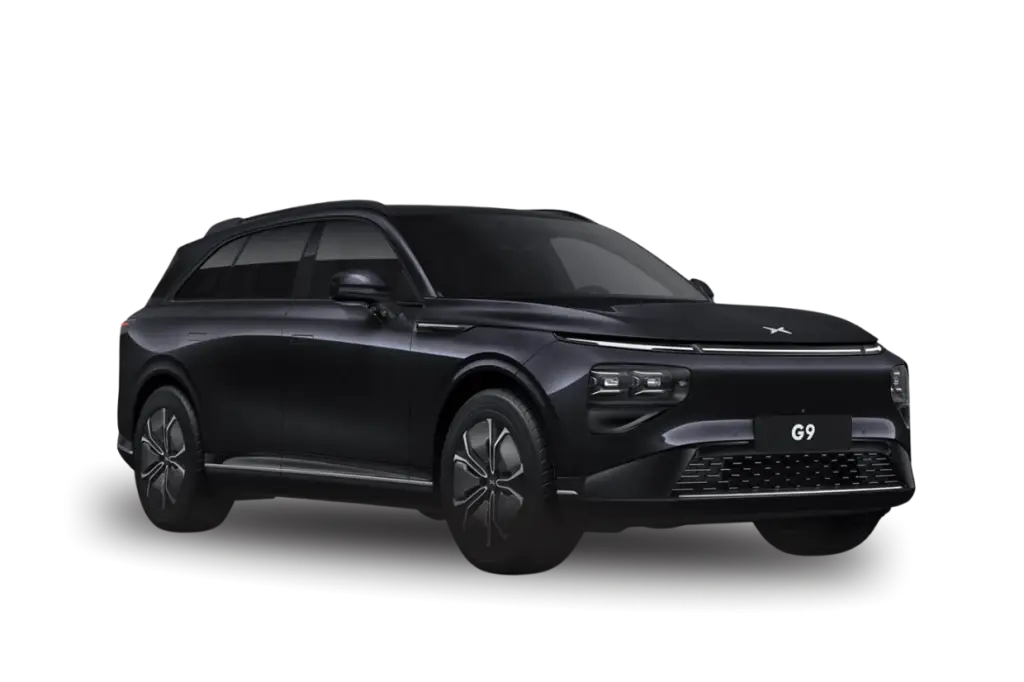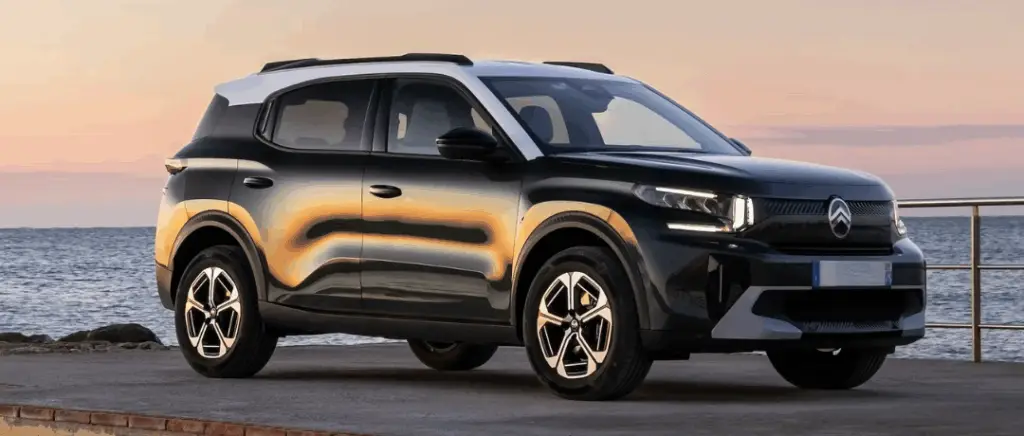Performance and engines: XPENG G9 or KIA EV9, which offers the best power for families and professionals?
Le XPENG G9 Performance boasts a very powerful electric drivetrain, with two motors delivering a combined output of 551 bhp (405 kW) and 717 Nm of torque, enabling acceleration from 0 to 100 km/h in just 3.9 seconds, as well as a top speed of 200 km/h. This all-wheel drive version, equipped with adaptive air suspension, guarantees a dynamic and comfortable drive, suited to the needs of both families and professionals looking for a premium, high-performance SUV. The chassis, developed with engineers based in Germany, ensures excellent handling and top-level roadholding.
Technically, the G9 is based on XPENG's SiC (silicon carbide) platform, dedicated to electric vehicles and compatible with 800-volt architecture, enabling ultra-fast recharging and optimised energy management. The platform also incorporates centralised electronics and advanced artificial intelligence technologies, with continuous software update capabilities, enhancing vehicle safety and connectivity.
La KIA EV9The G9 Performance offers two main engines: a 204bhp rear-wheel drive version (0-100kph in 8.2 seconds) and a 385bhp GT-Line 4-wheel drive version (600 or 700Nm of torque depending on trim level, 0-100kph in 5.3 seconds). Although the most powerful version of the EV9 still lags behind the engine of the G9 Performance, it nevertheless offers excellent versatility and performance for families and professionals, with optimised traction and appreciable driving comfort.
The EV9 is based on KIA's E-GMP (Electric-Global Modular Platform), designed specifically for electric vehicles. This platform provides optimum weight distribution, maximum interior space for up to 7 passengers and advanced battery integration, while offering excellent energy efficiency and rapid recharging.
Autonomy and charging: what is the real range and charging time between XPENG G9 and KIA EV9?
In terms of range, the XPENG G9 Performance boasts a WLTP range of 520 km with a battery of 98 kWh, while the KIA EV9, with its 99.8 kWh battery, can achieve a WLTP range of up to 774 km, depending on driving conditions and the version chosen. This difference is explained in particular by the energy management and on-board technologies, with the KIA EV9 being particularly optimised for long journeys.
When it comes to recharging, the XPENG G9 offers fast DC recharging of up to 300 kW, allowing 80 % of battery life to be recovered in around 20 minutes at a compatible charging point, while the KIA EV9 offers fast DC recharging of up to 210 kW, allowing 249 km of range to be recovered in 15 minutes. For domestic AC charging (11 kW), both models require around 9 to 11 hours for a full charge.
The XPENG G9 boasts an 800 V architecture for ultra-fast recharging times, while the KIA EV9 boasts exceptional range, ideal for families and professionals travelling long distances.
Design and finish: which of the two electric SUVs impresses with its style and comfort?
Exterior and interior design: XPENG G9 or KIA EV9, who's got the best style?
Le XPENG G9 is distinguished by an exterior design that is both imposing and elegant, with a vertical, futuristic front end featuring a large X-BOT LED light strip, imposing headlamp units and flush-fitting door handles that reinforce its premium character. The profile is fluid, the windows are frameless and the up to 21-inch wheels are reminiscent of those on top-of-the-range models. The sober rear end is marked by a transverse light bar.
Inside, the G9 is all about refinement, with top-of-the-range materials, Nappa leather seats, customisable ambient lighting and cutting-edge technology: two large touch screens, a 3D multimedia system, an intelligent voice assistant and automatic door closing. The customer experience is immersive, with new features such as a make-up mode for the front passenger and intelligent air suspension that makes it easier to access the vehicle.
La KIA EV9For its part, the new Mitsubishi has an original, modern exterior design, with 'Star Map' LED daytime running lights that give it a strong visual identity, a very clean rear line and vertical lights. The interior is designed around modularity and user-friendliness, with an open panoramic dashboard, sleek touch screens, a front and rear sunroof to give an impression of space, and second-row seats that rotate 180° to create a real living room inside. The ambience is bright, minimalist and focused on passenger comfort, with particular attention paid to ease of use and relaxation.

VS

Compare the XPENG G9 vs KIA EV9in our electric car comparison tool
Space and comfort: KIA EV9 or XPENG G9, which is the most spacious?
Le XPENG G9although designed for 5 passengers, offers a very generous interior space, with a wheelbase of 2,998 mm and a high level of comfort for all occupants. The front and rear seats are equipped with multiple electric adjustments, heating, ventilation and massage, while the front passenger benefits from a retractable electric footrest.
The boot is particularly spacious, with a basic capacity of 660 litres that can be extended to 1,576 litres by folding down the rear seats, making it an ideal choice for families or professionals who need to carry a lot of stuff. The cabin is luxurious and quiet, with particular attention paid to ergonomics and the quality of materials.
La KIA EV9can accommodate up to 7 passengers thanks to its three rows of seats, offering great versatility for large families. The interior is very open, with flat architecture, front and rear sunroofs, and second-row seats that rotate 180° to encourage conviviality.
The seats in the first and second rows have relaxation functions, and the entire cabin is designed to offer living-room-style comfort. However, the boot is smaller than that of the G9, with a capacity of just 333 litres (up to 828 litres when the third row is folded down), which may limit the space available for luggage.
Price and value for money: XPENG G9 or KIA EV9, which electric SUV is the best investment?
The XPENG G9 is positioned in the premium segment of electric SUVs with rates generally vary between €60,000 and €74,000 depending on the version chosen, with the 551bhp Performance version priced at around €74,000. Despite this high price, it offers particularly competitive value for money, especially when compared with equivalent models such as the Tesla Model X or BMW iX, which often cost twice as much or more.
The G9 boasts a comprehensive range of standard equipment: digital instrumentation, large central touchscreen, top-of-the-range upholstery, panoramic roof, electric tailgate, LED lighting, advanced driving aids, air suspension on the Performance version, and a WLTP range of 460 to 570 km depending on trim level. These features and range, combined with ultra-fast charging (up to 300 kW), make it an attractive choice for families and professionals looking for a premium SUV at a contained price.
The KIA EV9, meanwhile, is also aimed at the top end of the market, but more specifically at large families, thanks to its capacity to seat up to 7 people. Prices vary according to version and options, but are generally similar to or slightly higher than those of the G9, depending on the configuration chosen.
The EV9 also offers a high level of equipment, a WLTP range of up to 774 km on some versions, and rapid recharging of up to 210 kW. Its main assets are its modularity and passenger comfort, but it generally offers less acceleration than the G9 Performance.
Conclusion: XPENG G9 vs KIA EV9 comparison chart
| Criteria | XPENG G9 (AWD Performance) | KIA EV9 (AWD GT Line) |
|---|---|---|
| Power | 551 bhp (405 kW) | 385 bhp (283 kW) |
| Couple | 717 Nm | 600 Nm |
| Acceleration 0-100 | 3,9 s | 6.0 s (GT Line AWD) |
| WLTP range | 520 km (98 kWh battery) | 774 km (99.8 kWh battery, depending on version) |
| Real autonomy | 465 km (mixed winter/summer) | 435 km (mixed winter/summer) |
| Fast recharge | Up to 300 kW (80% in ~20 min) | Up to 210 kW (249 km/15 min) |
| Number of places | 5 | 7 |
| Boot volume | 660 L (up to 1,576 L folded) | 333 L (up to 828 L folded) |
| Starting price | 60,100 (depending on version) | 62,500 (depending on version) |
| Top-of-the-range prices | 74,000 (Performance) | 86,345 (GT Line Business) |
| Design | Futuristic, premium, high-tech | Modern, flexible, family-friendly |
| Comfort | Luxury, heated/ventilated/massage seats | Lounge comfort, rotating seats, sunroof |
| Value for money | Highly competitive, well-equipped | Good, but more expensive at high level |
































